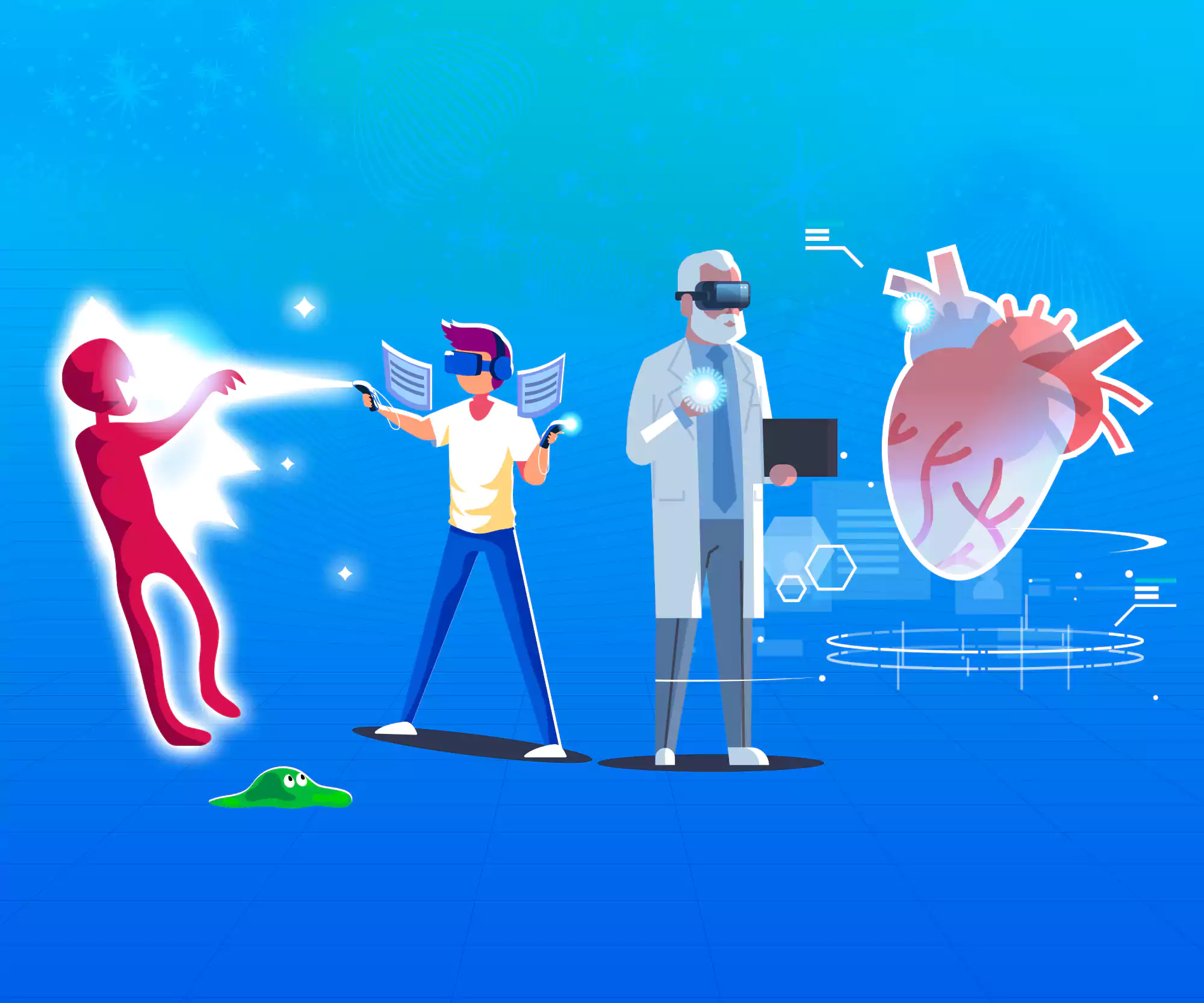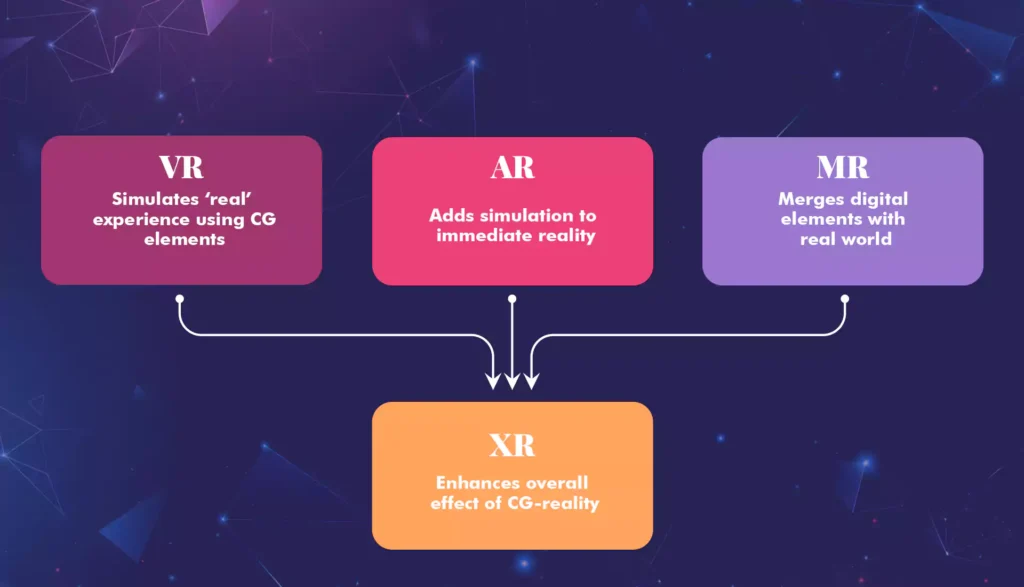
Reality as we know it is changing. As recently as just a few decades ago, experiencing and existing in the real world was the only option. However, in the past few years, new technologies have swept into the mainstream rapidly. As a result, there are currently multiple realities: virtual reality (VR), augmented reality (AR), mixed reality (MR), and even extended reality (XR). We bet all these realities sound intimidating. Moreover, you must also be wondering what sets them apart from each other. Let’s break down these ‘realities’, as well as the technologies behind them, and take a more detailed look at each.
Virtual Reality (VR)
Virtual reality, better recognised as VR, is a computer-simulated world or reality that attempts to offer the user an immersive, affective experience. With accessories (such as headsets) and advanced computer technology, VR creates a whole world in virtual form. This “fake real” world engages all five senses, i.e., taste, sight, smell, touch, and sound, to recreate a world of sorts for the users to insert themselves. As far as reality-tech goes, VR is the pioneer and is fairly well established today. To give you a teaser: imagine a racing game you have always loved playing. Now, instead of using consoles to control the bike or car in the game, you can experience a simulation where you ARE the driver. In this situation, imagine the sensorial engagement where you touch and feel the anticipation, the dread, the exhilaration, the joy, the whole gamut of emotions!
Besides gaming, VR can also have other practical applications in marketing, medicine (for envisioning), sports, and much more.
Augmented Reality (AR)
As the name suggests, AR takes the immediate reality and augments it, or ‘adds’ features, objects, and maybe someday even holographic versions of people. This augmentation, of course, requires devices and gadgets that can do the work of adding to what already ‘is’. Mobile phone or tablet cameras and unique types of headphones are generally used to augment reality. These work in unison to project digital content out into the environment. An easy way to think of AR would be to imagine a live, direct, or indirect view of a physical environment.
In actual reality, imagine superimposing computer-generated inputs like sound, videos, graphs, maps, etc. AR exists on top of our natural world, adding sensory benefits; augmenting and enhancing it further. Pokemon Go from a few years ago is an excellent example of AR. Even IKEA Place, the furniture store’s mobile app, uses AR. Shoppers get to select an item of furniture from their brochure. Then, they superimpose it on a specific location in their homes using AR software-hardware machinery. This feature gives them a relatively good idea of how the furniture would look in their home before buying it.
Mixed Reality (MR)
Mixed Reality or MR combines the real world with the virtual world. MR enmeshes digital elements in the real world, thereby improving the effects of both VR and AR. In MR, the user not only interacts with but also simultaneously manipulates both physical and virtual elements. Much like AR and VR, MR also requires fancy headsets. By employing sensing and imaging technology, MR allows the user to insert herself into the real world while immersed in a virtual world facilitated by headsets. Imagine being part of a high-octane action game with elements of your physical reality. Here, the digital and real worlds jumble together, enabling you to experience a new world.
While naysayers will quickly dismiss it as a state of being neither here nor there, it is a way of straddling two worlds simultaneously. Of course, it can get a tad risky as it deconstructs the reality we know and reconstructs it using real and imaginary elements. Undeniably revolutionary and bound to change how we exist, work, and play at some point, some everyday examples of MR are Snapchat filters and virtual makeup. Even furniture fittings make for a great commonplace use of MR. Special headsets virtually depict the furniture assembly, and you simultaneously use your hands to work with the fittings.
Extended Reality (XR)
Extended reality is a term used to denote all human-machine interactions that use wearable technology. An all-encompassing term that includes VR, AR, MR, and other cognates of these technologies, XR offers the best of all worlds. Using VR, AR, and MR, the real world can be enhanced using digital constituents. The mix of all three offers so far unseen experiences that are multisensory, interactive, effective, as well as affective.
Extended reality also has applications across a range of industries. Besides bringing remarkable improvements to entertainment and gaming, XR can radically change healthcare. By improving the tools available to surgeons, XR makes surgeries several times safer and more efficient. The first successful remote surgery occurred in 2001 when a New York surgeon used remote robotic controls and 360° screens. Over the past couple of decades, the applications of XR for doctors have improved even more. In 2016, a surgery was live-streamed at 360° using AR glasses. Thanks to XR, up to 13,000 healthcare professionals viewed the surgery from the surgeon’s point of view via an app and a headset. As explained by Nadine Hachach-Haram (founder of Proximie, a company that develops XR technology to train surgeons), surgeons can now “insert” themselves into challenging operations. They can offer step-by-step instructions throughout the surgery with just a smartphone and an AR headset.
It is also possible to use XR in other spheres of life: for creating unique marketing props, facilitating real estate sales by offering clients a real-feel experience of the house, for better corporate training, and EdTech.

An era of the new real
While reality is probably getting more interesting with VR, AR, MR, and XR, it is also making us more vulnerable to cyberattacks. In these enhanced realities, the threat level is high and the nature of attacks is unpredictable. XR technology is vulnerable to both traditional data breaches as well as immersive attacks. For example, an attacker can disorient users by overlaying images in their field of vision or by altering the virtual environment, thus causing the user to collide with physical objects. There can also be instances where assailants tweak the tools accompanying these technologies without the user’s knowledge. For example, attackers can enable head-mounted cameras without the user’s knowledge or permission. Other kinds of security breaches like hijacking personal information or controlling what is ‘experienced’ are also possible. Further intrusions can include malware attacks on wearable devices and disruption of operations.
Despite the flipside, VR, AR, MR, and XR are unstoppable. Humankind is eager to experience more human-machine interaction after having a small taste. And these interactions are looking ‘realer’ than ever!


